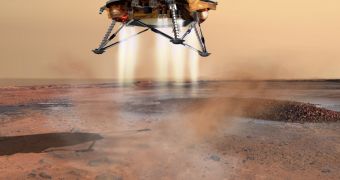In anticipation of the expected landing of the Phoenix Mars Lander on 25 May, NASA engineers applied a trajectory correction to the flight path. Further modifications to the flight path are expected after the Mars Reconnaissance Orbiter photographs the designated landing area. The Phoenix spacecraft will most likely land in a polar region known as "Green Valley," a flat valley about 100 kilometers long and 20 kilometers wide shaped in the form of an ellipse, containing high amounts of water ice.
"Our landing area has the largest concentration of ice on Mars outside the polar caps. If you want to search for a habitable zone in the arctic permafrost, this is the place to go," said University of Arizona principal investigator for the mission, Peter Smith. After landing, Phoenix will start digging into the ice layer, in order to study the soil and water for evidence of clime cycles and weather appropriate for life.
"We have never before had so much information about a Mars site prior to landing. The environmental risks at landing - rocks and slopes - represent the most significant threat to a successful mission. There's always a chance that we'll roll snake eyes, but we have identified an area that is very flat and relatively free of large boulder," said Ray Arvidson from the Washington University, chairman for the Phoenix landing-site work group and part of the team that landed the Viking probes in 1976.
During the correction trajectory maneuver, Phoenix executed a 145-degree rotation around its axis, so that the main antenna dish would be pointed towards Earth. Before entering Mars' atmosphere on 25 May, Phoenix will execute additional maneuvers in order to position itself into a flight path that will take it to the designated spot.
After these corrections are made, the spacecraft will have to decrease from its current speed of 21,000 kilometers per hour, before releasing its parachute at an altitude of 914 meters about the planet surface to slow to a speed of only 8 kilometers per second and land safely.
"Landing on Mars is extremely challenging. In fact, not since the 1970s have we had a successful powered landing on this unforgiving planet. There's no guarantee of success, but we are doing everything we can to mitigate the risks," said Doug McCuistion, director of NASA's Mars Exploration Program.

 14 DAY TRIAL //
14 DAY TRIAL //